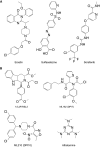Mechanisms of ferroptosis
- PMID: 27048822
- PMCID: PMC4887533
- DOI: 10.1007/s00018-016-2194-1
Mechanisms of ferroptosis
Abstract
Ferroptosis is a non-apoptotic form of cell death that can be triggered by small molecules or conditions that inhibit glutathione biosynthesis or the glutathione-dependent antioxidant enzyme glutathione peroxidase 4 (GPX4). This lethal process is defined by the iron-dependent accumulation of lipid reactive oxygen species and depletion of plasma membrane polyunsaturated fatty acids. Cancer cells with high level RAS-RAF-MEK pathway activity or p53 expression may be sensitized to this process. Conversely, a number of small molecule inhibitors of ferroptosis have been identified, including ferrostatin-1 and liproxstatin-1, which can block pathological cell death events in brain, kidney and other tissues. Recent work has identified a number of genes required for ferroptosis, including those involved in lipid and amino acid metabolism. Outstanding questions include the relationship between ferroptosis and other forms of cell death, and whether activation or inhibition of ferroptosis can be exploited to achieve desirable therapeutic ends.
Keywords: Cancer; Cell death; Erastin; Ferrostatin-1; Glutathione; Glutathione peroxidase 4; Iron; Polyunsaturated fatty acid; RAS; Reactive oxygen species; Sorafenib.
Figures



References
Publication types
MeSH terms
Substances
Grants and funding
LinkOut - more resources
Full Text Sources
Other Literature Sources
Research Materials
Miscellaneous

